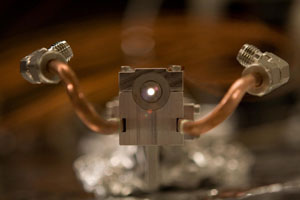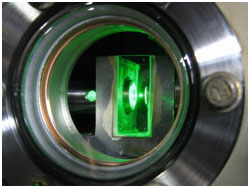Research
- Comprehensive Control of Atomic and Molecular Motion
- Applications to New Materials and Processes
- Optical Trapping and Cooling of Glass Microspheres
Comprehensive Control of Atomic and Molecular Motion

The ability to observe and control matter has been one of the holy grails of modern science. This is a very broad goal, ranging from sub-atomic particles, to atoms, molecules, nanoparticles, and ultimately materials science. For atoms in gas phase, laser cooling has been the standard method of control for over thirty years. While it is an extremely successful method, laser cooling requires a two-level cycling transition, and has thus been limited to a small fraction of the periodic table. Laser cooling has also saturated in the number of ultra-cold atoms produced per second, as well as their phase space density. A second method, evaporative cooling, is employed to further cool atoms to quantum degeneracy. It is even less general than laser cooling, is typically slow, and entails a large loss in atom number. It is natural to ask whether there could be an alternative approach to laser cooling and evaporative cooling that could break these barriers.
In response to this challenge, we have been developing new methods of cooling and trapping atoms. The starting point for our work is the supersonic beam which is a standard tool in Physical Chemistry. The supersonic beam serves as a universal platform for cold but fast atoms that are seeded or entrained into the flow. We proposed that a series of pulsed magnetic field coils could stop and trap any paramagnetic species. This "atomic coilgun" was inspired by the coilgun which is used to launch large projectiles. Using this device, we have stopped a beam of metastable neon atoms, as well as a beam of molecular oxygen. Most atoms are paramagnetic in their ground state, or can be excited to a metastable state that is paramagnetic. This approach is therefore extremely general, depending only on the ratio of magnetic moment to mass. We proposed that the atomic coilgun could be operated as an adiabatic decelerator, conserving phase space. This was recently demonstrated by the Narevicius group at the Weizmann Institute. The combination of the supersonic beam and the adiabatic coilgun already has the promise to surpass laser cooling in terms of generality and flux, without using any lasers at all! In order to increase the phase-space density, we proposed a new method of cooling that requires lasers, but for a different purpose than laser cooling.
The method is based on a self-acting one-way wall for atoms that we proposed, and realized experimentally. The basic ingredients for the operation of this one-way wall are laser optical pumping of atoms, and magnetic forces. An interesting historical side-note: In 1871, James Clerk Maxwell proposed a thought experiment known as Maxwell's Demon. In one letter, to Lord Kelvin, Maxwell said that the demon is "impossible to us." In a second letter, to Lord Rayleigh, Maxwell wrote that the demon could be a self-acting one-way wall, predicting the ultimate experimental realization in our laboratory. The cooling in our case is due to the increase of the photon entropy as it is scattered from the laser beam, which compensates for the decrease in the entropy of the gas. This concept was first proposed by Leo Szilard in 1929 in an effort to resolve the paradox of Maxwell's Demon. Our method can work on any atomic element or molecule that can be optically pumped. We recently proposed a version of this cooling method in three dimension, termed magneto-optical (MOP) cooling, which will soon be demonstrated experimentally. The above methods hold promise as alternatives to laser cooling and evaporative cooling, both in generality and flux, which will have an important impact on applications of ultra-cold atoms.
Applications to New Materials and Processes

We are developing an aberration-corrected magnetic lens for atoms in order to focus them to spot sizes well-below 10 nm, which will enable the development of the world's first neutral-atom microscope that is chemically sensitive and surface specific. The microscope would use metastable noble-gas atoms, which deactivate on impact with a surface, in a process of Penning ionization. The inelastic interaction with surface states results in a unique molecular spectral signature of the emitted electrons, which has been extensively studied. Our microscope will be able to probe local features at the nm level, providing details of chemical composition and reactivity.
We are also applying the general cooling methods described above to the problem of efficient isotope separation, and have published and patented these results. This work will have an important impact on production of much-needed isotopes for medicine, specifically imaging and cancer therapy, and is now being further developed at a non-profit entity, the Pointsman Foundation, www.pointsman.org

Optical Trapping of Glass Microspheres
Over the past few years we have built a new experiment to trap micron-sized glass beads in liquid, air, and vacuum. We have also built a novel detecting system to monitor the real-time position of a trapped bead on very short time and length scales.

Over the past few years we have built a new experiment to trap micron-sized glass beads in liquid, air, and vacuum. We have also built a novel detection system to monitor the real-time position of a trapped bead on very short time and length scales.
One motivation for this work was a long-standing prediction in physics: In 1907, Albert Einstein published a paper where he considered the instantaneous velocity of a Brownian particle, and showed that it could be used to test the equipartition theorem, one of the basic tenets of statistical mechanics. However, Einstein concluded that it would be impossible to measure instantaneous velocity in practice due to the very rapid randomization of the motion.
We have now measured the instantaneous velocity of a Brownian particle, over 100 years since the prediction by Einstein. Our velocity data was used to verify the Maxwell-Boltzmann velocity distribution, and the equipartition theorem for a Brownian particle. We recently conducted similar measurements in liquid, and resolved the instantaneous velocity. The physics in the case of liquid is much richer, and therefore more interesting, than air. This system will enable a precise test of the equipartition theorem for a classical liquid. We plan to use this system to study thermodynamics and statistical mechanics of small systems out of equilibrium, and the emergence of the "arrow of time."
We will use the verified energy equipartition theorem at short times to “weigh” a microscopic particle at the pico-gram level by fitting the mass to the observed Maxwell-Boltzmann distribution. We will use this system to study the onset of ice-nucleation in saturated vapor, a phenomenon of great interest to atmospheric science, with important potential applications towards cloud seeding to produce rain. The problem of heterogeneous nucleation will also be studied in a super-cooled liquid, and will serve as a new testing ground for theory. Super-cooled liquids are model systems for studying the glass transition, and heterogeneous nucleation in such systems is still poorly understood.
Link to current research